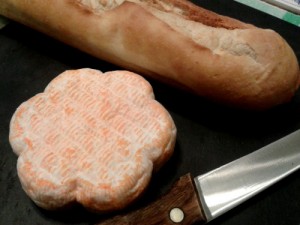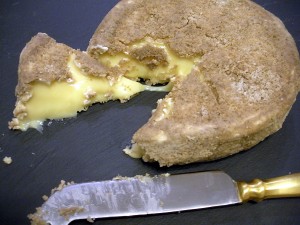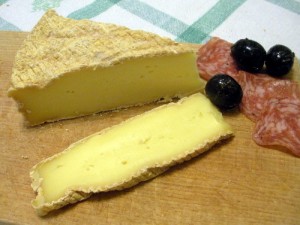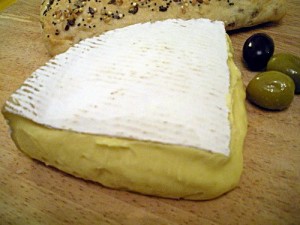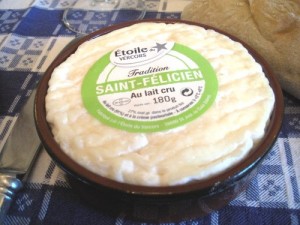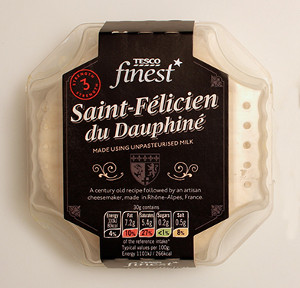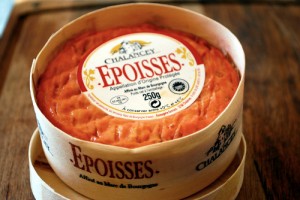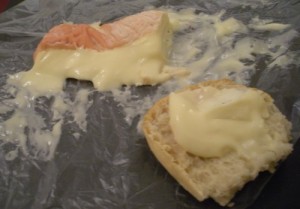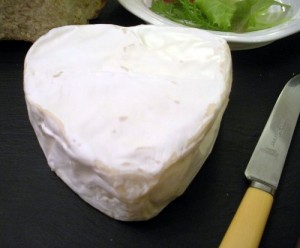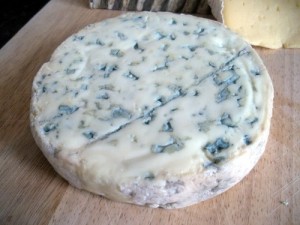Archive for the ‘Cow’s milk’ Category
St. Albray
March 31st, 2019 Posted 7:06 pm
This is one of the first cheeses we ever reviewed. However, we weren’t taking photos at this point. Nearly nine years later, we found some for sale in a visiting French market.
Many years ago, we decided to start taking notes about the various cheeses we had tried. This was one of a handful of cheeses included in that first week’s record. We recorded it as “Petit Tourtain”. Four months later, we reviewed it again under the name “St. Albray”, completely unaware that it was, in fact, the same cheese.
To be honest, we’re still slightly confused about the naming of the cheese. It is understood that St. Albray is the recognised name of the cheese. Normally, it is made in a large 1½Kg form, with the smaller (200g) version being referred to as “petit”. Seeing as the cheese is not protected by AOC status, it is entirely possible that other cheesemakers around France are producing bootleg versions.
The first thing we notice about the cheese is it’s six lobed flower shape. The rind is a pinky / orange colour dusted with white.
The pate is a pale cream colour, soft, slightly rubbery with a waxy texture. It has almost no smell at all.
The taste is very delicate, slightly salty, bittering slightly closer to the rind.
In summary, it’s not a very exciting cheese. The best things about it are the texture and the fact that it’s pretty. It would make a good addition to a cheeseboard for non-cheeselovers.
We have reviewed this cheese three times now, and our opinion hasn’t changed.
Reviewed by Nick & Olympia, 2010 & 2019




 (1.5/5)
(1.5/5)
Posted in 1 Star - Meh, Cow's milk, French, Semi-soft, Washed
Camembert au Calvados
February 10th, 2019 Posted 7:14 pm
Just when you thought Camembert couldn’t get any more interesting…
…they cut off the rind, dip it in a Calvados and cider mixture, and then roll it in biscuit crumb. How wonderful! (Calvados is a brandy made from apples rather than grapes.)
The result is this rather crusty appearance with gooey, yumminess oozing out.
The crust smells very strongly of fermenting fruit with a slight disinfectant smell about it. The pate is typical of a Camembert, pale yellow and gooey with identical creamy, sticky texture.
The taste is an interesting mix of bitter, sweet and fruity with chemical, acetone notes, a bit like pear drops and cellulose varnish. There is also, unsurprisingly, a strong alcoholic element in this mix. The strong aftertaste has a pronounced metallic quality.
In closing, it is an interesting cheese. One to impress guests with, because of it’s unusual and unique nature. As a cheese to savour and enjoy, not so much. It is a little intense, best eaten in small quantities.
Purchased from: Champagne + Fromage, London
Reviewed by Nick & Olympia, 2017




 (3.5/5)
(3.5/5)
Posted in 3 Stars - Good, Cow's milk, French, Soft, Washed
Milleens
February 3rd, 2019 Posted 6:41 pm
Now there’s a cheese that looks like a proper rustic, traditional farmhouse cheese that has been made for many generations. It is however, a relatively modern creation, first produced in 1976.
From the rugged, but lush Atlantic coast of the furthest south western corner of Ireland. The Beara Peninsular, County Cork, is home to the herd of Friesian cows that provide the milk for this cheese, giving it almost alpine like qualities.
On the outside, its course orangey, light brown rind smells somewhat like a Parisian concrete pissoir: earthy with an overpowering ammonia content.
The pate, is rubbery, soft and yielding, with a waxy feel and look. The smell is pleasantly milky with no trace of the ammonia that so dominates the rind.
The smooth, waxy texture has a mild, slight bitter edge at first bite, that quickly fades, revealing a subtle Morbier like herbaceous, alpine flavour with vague, but elusive hints of caramel that you’re never really certain were there.
All in all, it’s a good cheese. Pleasant, but not terribly exciting.
Manufactured by Milleens Cheese Ltd.
Purchased from Cheesology
Reviewed by Nick and Olympia, 2018




 (3/5)
(3/5)
Posted in 3 Stars - Good, Cow's milk, Irish, Semi-soft, Washed
Waterloo
January 14th, 2018 Posted 6:28 pm
Just look at it! Oozy gorgeousness. It promises so much, but does it deliver?
|
It’s delicately cornflour dusted rind, and gooey golden pate oozing out. This is an award winning cheese, consistently winning medals in the British Cheese Awards and twice winning a medal in the World Cheese Awards. It has absolutely no smell, which, for some might signal concern. The texture is divine: smooth, creamy and deliciously silky. The flavour is salty and slightly bitter. Other than that, there is nothing. Most disappointing |
Lovely consistency, no real flavour. Despite it’s award winning status, we didn’t think much of it… a real shame.
Manufactured by Village Maid
Purchased from Cheese Please, Lewes
Reviewed by Nick & Olympia, 2013




 (2/5)
(2/5)
Posted in 2 Stars - OK, Cow's milk, English, Soft
Somerset Chilli
June 4th, 2017 Posted 6:22 pm
We don’t tend to review reformed flavour added cheeses, but every now and again one comes along that’s worth a mention.
Reformed flavour added cheeses tend to be a mass production cheddar like cheese, that has been broken up into small chunks, mixed with some form of vegetation and then pressed back into a cheese shape. Most supermarket flavour added cheeses are made like this, and to be honest, are a bit “trick”.
This particular cheese appears to be based on a cheddar, with added green and red chillies and coated in cracked black pepper.
Hot, hot, hot! If you like spicy food, you’ll like this. It’s not so hot that you cannot taste the cheese, but it is hot enough to make your tongue burn and lips tingle. Strangely, the black pepper coated rind is actually hotter than the chilli laced interior.
To be truthful, it’s nothing special, from an artisan cheese perspective, but is included because it’s fun. If you have a known chilli-head coming to dinner, this will keep them happy.
In summary, like a Las Vegas showgirl, hot and fun, but not serious.
Produced by Somerset Cheese Company
Reviewed by Nick & Olympia, 2013




 (2.5/5)
(2.5/5)
Posted in 2 Stars - OK, Cow's milk, English, Flavour added, Hard
Saint Félicien
March 5th, 2017 Posted 7:58 pm
FREE! terracotta dish with every cheese!… well sometimes.
In France, it is traditional to sell Saint Félicien in shallow terracotta or eathenware dishes, although some manufacturers ship in shallow wooden boxes like a Camembert.
|
The reason for this is that the cheese is prone to becoming extremely runny and leaking whey. It also spoils easily if not allowed to breath. As a result, it doesn’t travel very well, which means it was quite difficult to get hold of. |
|
…and it is really very good. This normally fragile cheese is now easily available throughout the UK, its lush creaminess preserved for all enjoy. Yay!
Saint Félicien is officially categorised as an aged, fresh cheese, which basically means that it’s a couple of weeks old. The very soft yielding rind is a pale yellow, dusted with white mould. The smell is somewhat reminiscent of a freshly talcum powdered baby, sweet with a slight rancid background smell (cue the flood of e-mails from angry mothers). The pate can be almost liquid, requiring a spoon to serve and as it ages, it will also weep quite a lot of whey. Unsurprisingly, for a cheese that could probably be scientifically classified as a liquid, It has a deliciously smooth, creamy texture. The taste is delicate. Sour cream with a slightly fruity tang and nutty edge. As it ages, it will quickly start to become sour and bitter. After too long, it can become quite unpleasant. The trick is to catch it when it just starts to become runny and eat it within a week or two. |
Saint Félicien is one of those classic French cheeses that, until recently, was rarely spotted outside France. Now, thankfully, it has a regular spot on our cheeseboard.
Reviewed by Nick & Olympia, 2013.




 (4/5)
(4/5)
Posted in 4 Stars - Very Good, Cow's milk, French, Soft
Époisses
February 26th, 2017 Posted 8:10 pm
Époisses lays claim to being the smelliest cheese in the world. So smelly and offensive, that open carry is forbidden on the Paris Metro… apparently.
This is how it is presented in shops:
…however, unless you purchase the whole forme, this is how it will appear when you get it home:
The origins of this cheese date back to the 16th century and those naughty Trappist monks putting alcohol in everything. The cheese is washed with a mixture of brandy and brine. Though it is highly unlikely that the monks knew it at the time, a particular strain of bacteria (brevibacterium linens), notably responsible for smelly feet, was a key part of the recipe.
A popular cheese, it continued to be manufactured by many farms in the area. Then due to WW2, production ceased. The recipe was never recorded and only passed on from generation to generation through word of mouth.
Luckily, in 1956, the Berthauts, a couple of farmers near Dijon, had the foresight to revive the cheese and sought out the last surviving individuals who knew how to make it.
Époisses has a sticky orange rind. Did I mention, it’s also rather smelly? Maybe not as bad as expected by its claim of “the world’s smelliest cheese”, but certainly very pungent. Sweaty, smelly socks with a hint of slurry. It sounds horrible but to the hardened cheese connoisseur, it’s heaven (yes, we’re weird like that ![]() ). Sometimes, there is a strong smell of ammonia, but more about that in a moment.
). Sometimes, there is a strong smell of ammonia, but more about that in a moment.
The inner pate is a light creamy colour and should be soft and gooey or runny depending upon ripeness.
The texture is deliciously smooth and creamy and the flavour, perhaps surprisingly, is quite delicate. The pungent aromas are still present in the taste, but very subdued. There is also a wine reaction, that so often occurs with washed cheeses, in the form of delicious fruity notes that magically appear.
A note of warning. Éposses is one of those cheeses that really needs to be stored properly in order to get the best out of it. It is therefore, highly recommended that it be purchased from a proper fromagerie. Supermarkets do sell it, but very often it will lack the expected pungency and gooey decadence. Typically, supermarket sell-by dates are too short for refrigerated storage and the cheese is not fully ripe by the date indicated. In the opposite extreme, it can also become over-ripe and bitter, the aforementioned ammonia smell is a good indicator of this.
Époisses is a real classic cheese that is famous throughout the world. Don’t let bad supermarket experiences put you off, when this cheese is good, it is awesome.
Reviewed by Nick & Olympia, 2012




 (4/5)
(4/5)
Posted in 4 Stars - Very Good, Cow's milk, French, Soft, Washed
Wyfe of Bath
February 19th, 2017 Posted 5:18 pm
“Experience, though noon auctoritee, Were in this world, were right y-nough to me, To speke of wo that is in mariage; For, lordinges, sith I twelf yeer was of age.”
- Geoffrey Chaucer
From whence this cheese doth get it’s name… apparently.
|
According to the manufacturer, like Chaucer’s tale, this cheese is like a taste of old England. It certainly smells, old. It has this wonderful smell of old, damp stone, reminiscent of a church crypt. Formed in cloth lined baskets, the cheese is shaped like a large round soap bar, with a tough, leathery, orange / grey, natural rind. Inside, the pate can vary from a pale yellow to a light golden colour, with a firm but yielding, slightly rubbery, but creamy texture. The taste is initially quite sharp, with delicate hints of fungus and stone. The sharpness quickly melts away leaving a pleasing nutty, grassy flavour. |
All in all a pleasant cheese to nibble on with a glass of red wine.
Produced by The Bath Soft Cheese Co.
Reviewed by Nick & Olympia, 2011.




 (3/5)
(3/5)
Posted in 3 Stars - Good, Cow's milk, English, Hard
Cœur de Neufchâtel
February 12th, 2017 Posted 7:50 pm
Well, it’s St. Valentine’s day (almost) and I’ve been trying, for years, to write up this one at around this time of year, but always missed. Yes, I know… cheesy, but when you have a heart shaped cheese, waddya gonna do?
To be fair, it isn’t the only heart shaped cheese, and Neufchâtel is not always heart shaped. It can be found in other forms, logs, wheels and bricks.
|
Regardless of the shape, Neufchâtel has a soft, smooth, velvety rind, covered in a fine white mould. The smell is very mushroomy with hints of ammonia. The pate is gooey and pale yellow just inside the rind, but almost white and crumbly in the centre. It has a very slight buttery smell that is almost non-existent. The taste is immediately salty, quickly giving way to a pungent flavour accompanied by a burning sensation. There is no real after taste, but it leaves you with the burning and an anæsthetic sensation. It is also one of those cheese that has an interesting effect when taken with wine, producing a strange metallic taste. A bit of a wolf in sheep’s clothing. You think it’s going to be mild mannered, a soft creamy, delicate cheese in a lovely little heart shape. But, then it bites. It’s a bit of an unusual cheese and one to try because of it, but to be honest, it’s a little overrated. |
Purchased from the cheese stall outside Brighton Station.
Reviewed by Nick & Olympia, 2012.




 (1.5/5)
(1.5/5)
Posted in 1 Star - Meh, Cow's milk, French, Soft
Fourme d’Ambert
January 29th, 2017 Posted 6:48 pm
Fourme d’Ambert is one of the oldest known cheeses, dating back to the Roman occupation of France, around 2,000 years ago. The recipe, that is, not the actual cheese which is normally only aged for a month or two.
Traditionally made in a cylindrical “fourme” (French Auvergnat dialect for mould) about 5½” (13cm) diameter and 7½” (19cm) tall, the wheel is unusually tall for its diameter. Usually, it is sold in slices across the wheel rather than wedges.
Soft and yielding, almost spreadable, dusted in a white/grey mould. The pate is off white to dark cream (depending upon age) and flecked with greenish blue. It’s a delightfully appealing cheese from the offset.
The smell is slight, almost non-existent. The texture is deliciously smooth and creamy, yielding pleasantly in the mouth. The flavour likewise is smooth and creamy, delicate with hints of blue. It could be described as similar to a very mellow Roquefort, not so sharp and a lot less salty.
It is a generally pleasant cheese, inoffensive and well behaved. A perfect blue addition to the cheeseboard when you might not want to overwhelm your guests.
Easily available from many supermarkets.
Reviewed by Nick & Olympia, 2011.




 (4/5)
(4/5)
Posted in 4 Stars - Very Good, Blue, Cow's milk, French, Semi-soft

